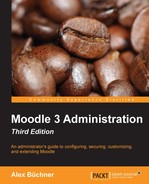User management in an organization is a critical subject for a variety of reasons:
- Once implemented, it is difficult to change
- A system that is too simple is potentially unsafe and not future-proof
- A system that is too complicated is unlikely to be accepted by users and is likely to cause administrative difficulties
There is no ideal user management scheme since the preference in every organization is different. However, there are a number of issues that are considered to be best practice.
Usernames have to be unique. The simplest way to implement this is to give each user a unique number, which is never reused even after students have finished a course. However, such a number-based system will be very difficult for learners to remember, especially younger learners. It is, therefore, necessary to come up with a more user-friendly scheme considering the following potential issues:
firstname.lastname: This causes difficulties when the same name exists twiceclass.firstname.lastname: This causes difficulties when the same name exists twice in a class or group. Also, when learners transfer from one class/group to another, there is scope for a potential conflict.startyear.firstname.lastname: This causes difficulties when the same name exists more than once a year. Furthermore, students who have to repeat a class or join a school at a later stage will be out of sync with the rest of the pupils in the same class. The same holds true for theendyear.firstname.lastnamenaming scheme.
A system-compliant naming scheme would, therefore, be startyear.firstname.lastname, with an optional number added in case there is an overlap. Students who repeat or join the school at a later stage would then be changed manually so as to be in sync with the rest of their peers in the year. Some examples of this are 12.michael.stipe, 13.leonard.cohen.1, 13.patti.smith.2, and 14.bob.dylan.
For smaller learning organizations, a system that uses firstname.lastname as a scheme with an added number (in case of name duplication) is usually sufficient. The same applies to training providers who have rolling start dates for users.
Some organizations still do not make use of e-mail addresses. As it is a compulsory field in Moodle, it is necessary to work around this issue. You will have to come up with a unique dummy e-mail address scheme or void e-mail addresses that have to be used for identification purposes. In order to avoid the usage of the actual e-mail address, it is necessary that you deactivate it in the user's profile.
